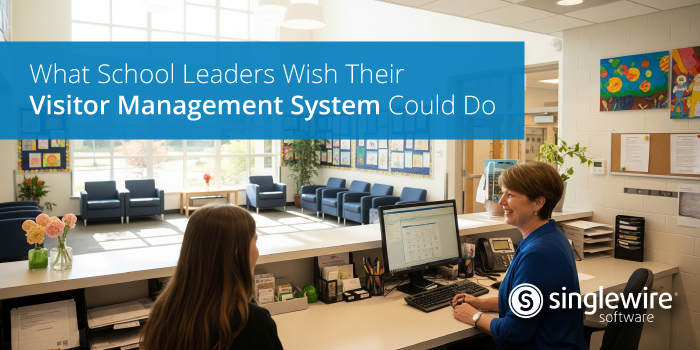Adding Flexibility Without Sacrificing Safety
Managing who comes and goes from a school building has become a front-line priority for education leaders. And for school staff across departments—from principals and superintendents to security personnel, facilities managers, and front office staff—visitor management systems are becoming essential tools for creating safer, more efficient environments.
Yet far too many schools are still stuck with visitor management solutions that create more problems than they solve: outdated hardware, disconnected systems, limited flexibility, and processes that put extra pressure on staff.
So what would a visitor management system look like if it were truly designed with K-12 schools in mind? Here are seven features school leaders consistently wish their system offered—and what to look for when choosing a solution that supports safety, simplicity, and daily operations.
1. Freedom From Proprietary Hardware
Supporting proprietary check-in hardware like badge printers and scanners can be a burden for school IT staff and front office teams. These devices often require updates, maintenance, and vendor-specific parts that slow down check-in and create support headaches.
A modern visitor management system should work on the devices schools already have. That means web-based check-in that runs in a browser or through an app on a tablet, with no special equipment required. If badges are needed, the best systems support widely available commercial printers that give schools the flexibility to choose one that fits their needs and budgets.
2. Identity Verification Without Manual ID Handling
Asking guests to physically hand over their ID slows down the process and can introduce safety concerns. Even handing an ID over to a machine can create issues if it it gets stuck during the scanning process.
Newer platforms offer more flexible identity verification, using tablets for facial recognition, secure digital ID uploads, or pre-registration links that collect information ahead of time. These methods speed up check-in, reduce staff burden, and improve accuracy.
3. Seamless Integration with School Safety Systems
Visitor management shouldn’t operate in a silo. The right system should connect with other tools your school already uses—such as emergency notification platforms and access control to add value and expand usability.
These integrations help schools:
- Automatically restrict access to certain buildings or times
- Notify staff or security when a visitor arrives
- Send alerts when banned visitors attempt entry
The more your VMS integrates, the more it becomes part of a comprehensive safety strategy.
4. Remote Configuration and Centralized Management
Districts managing multiple schools or campuses need a consistent approach to visitor management. With centralized management, district leaders can monitor activity, enforce uniform policies, and update workflows from a single dashboard—without going on site.
Schools should be able to manage:
- Visitor types (e.g., parent, contractor, volunteer)
- Required check-in questions or documents
- Watchlists or entry restrictions
This approach ensures a consistent experience for every school and reduces the burden on front office staff.
5. Strong Security and Privacy Controls
Visitor management systems collect sensitive data like names, photos, visit history, and contact details. That means protecting that data is non-negotiable.
A VMS designed for schools should include:
- Role-based access controls for staff
- Encryption of visitor data in transit and at rest
- Automatic data deletion settings to align with retention policies
- Detailed logs to support compliance and auditing
These features help schools stay compliant with data privacy laws and build trust with families.
6. Scalable Licensing Without Surprise Fees
Some visitor management vendors charge by the number of kiosks, which can limit expansion and needed flexibility for times when there is an influx of visitors.
Look for VMS providers that offer reasonable pricing models that help ensure schools can expand usage when needed without worrying about unexpected costs.
7. Minimal Burden on Front Office and Support Staff
The best visitor management systems make life easier for everyone—especially the staff who use them every day. That means:
- Easy-to-navigate interfaces
- Self-service check-in options for guests
- Automation of common tasks like badge printing or notifying hosts
When the system is simple and intuitive, fewer people need training, and fewer issues end up with IT or administration.
Building a Safer, Simpler School Experience
Visitor management has become more than just a front desk function. It plays a vital role in creating secure, welcoming environments for students, staff, and families.
For school leaders looking to upgrade their visitor processes, choosing a system with flexibility, security, and ease of use at its core is key. From reducing manual work to tightening access control, the right tools can help schools improve both safety and efficiency.
And best of all, they can do it without adding more work to already-stretched teams. Check out our Visitor Aware solution if your school is looking to enhance front entrance security.
